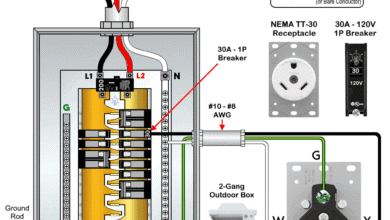Auto & Manual Control of 3-Phase Water Pump Motor using Float Switch
Automatic and Manual Control of Three-Phase Water Pump Motor using Float Switch and DOL Starter
Three-phase water pump motors are extensively used in various applications such as water supply systems, irrigation, and industrial processes. Efficient control of these motors is crucial to ensure optimal performance and prevent wastage of resources.
By integrating a float switch and a DOL (Direct-On-Line) starter, both automatic and manual control of three-phase water pump motors can be achieved. In this article, we will explore the technical aspects of automatic and manual control of a three-phase water pump motor using a float switch and DOL starter.
Float Switch
A float switch is a device used to detect the level of liquid in a tank or reservoir. It consists of a buoyant float attached to an electrical switch. The switch is actuated by the movement of the float as the liquid level rises or falls.
The float switch works on the principle of buoyancy. When the liquid level rises, the float also rises, lifting the switch. This upward movement triggers the switch to activate or deactivate a connected electrical circuit. Conversely, when the liquid level decreases, the float falls, causing the switch to return to its original position.
Float switches are commonly used in various applications, including water tanks, sump pumps, sewage systems, and industrial processes. They provide a simple and reliable method for controlling the liquid level, allowing for automated operation and protection against overflow or dry running of pumps or other equipment.
Float switches can have different configurations depending on the specific application requirements. They may feature single or multiple switch points to control different levels of liquid, and they can be designed for use with different types of liquids, such as water, oil, or chemicals.
DOL Starter
A DOL starter, also known as a Direct-On-Line starter, is a common starting method for three-phase motors. It provides a simple and reliable means of starting and stopping the motor. The DOL starter consists of a contactor and an overload relay.
When the motor is started, the contactor closes, allowing power to flow directly to the motor. The overload relay protects the motor from excessive current by opening the circuit in the event of an overload.
Components Needed
- Water Pump Motor – 3-Phase
- MCCB – 400V, 3-Poles
- Contactor
- Thermal Overload Relay
- ON/OFF Selector Switch
- Float Switch
- NO & NC Switches
- 400-415V Three-Phase AC Supply
- Wires and Cables and additionally indicators based on the circuit design.
Wiring & Control Diagram
The following wiring, power and control diagram shows how to control a 400V three-phase water pump motor using a float switch and DOL starter for both manual and automatic operations.
Click image to enlarge
Manual Control & Operation:
In manual mode, the float switch is connected to the control circuit of the DOL starter. The control circuit includes a Start button and a Stop button. When the knob of ON/OFF selector switch is on Manual (M) position, and the liquid level falls below the desired level, the float switch triggers the control circuit, which activates the DOL starter.
Pressing the Start button energizes the contactor, allowing power to flow to the motor, and the motor starts running. To stop the motor, the Stop button is pressed, de-energizing the contactor and disconnecting the power supply.
Manual control using a float switch and DOL starter offers a straightforward and reliable method for operating a three-phase water pump motor. It allows users to manually regulate the water level based on their requirements. However, continuous monitoring is necessary to ensure that the motor is turned on or off at the appropriate times.
Automatic Control & Operation:
To achieve automatic control, additional components such as a relay, contactor and a control circuit are integrated into the system. This operation is activated when the knob of the ON/OFF selector switch is on Automatic “A” position.
The float switch is connected to the control circuit, which acts as an intermediary between the float switch and the DOL starter. The control circuit interprets the signals from the float switch and controls the operation of the DOL starter accordingly.
In automatic mode, when the water level falls below the desired level, the float switch triggers the control circuit, which activates the DOL starter. The control circuit energizes the relay, which in turn energizes the contactor, allowing power to flow to the motor.
As a result, the motor starts running and pumps water until the float switch indicates that the desired water level has been reached. At this point, the control circuit deactivates the relay, cutting off the power supply to the DOL starter, and the motor stops.
Summary
Automatic control offers several advantages over manual control. It eliminates the need for constant monitoring, allowing the system to operate independently. It ensures that the water pump motor operates only when necessary, preventing unnecessary power consumption and wear on the motor. Additionally, automatic control enhances safety by reducing the risk of overflows or dry-running of the motor.
Related Posts:
- Automatic & Manual Control of 3-Phase Motor Using Delay Timer
- How to Start & Stop a 3-Phase Motor Using Direct-On-Line (DOL) Starter?
- How to Wire ON/OFF Delay Timer for AC & DC Loads – 230V & 24V







